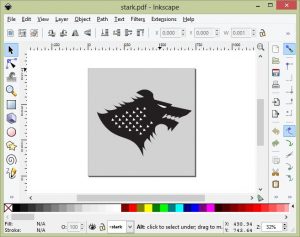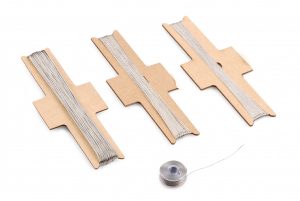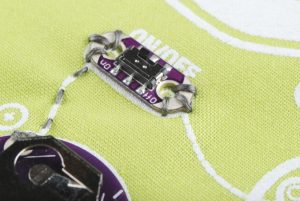This week, our class met at the Fab Lab and learned how to laser cut wood and how to sew conductive thread into fabric. Unfortunately, I was sick this week and was not able to attend. Therefore, for my weekly reflection, I’ve researched these two activities and will share what I’ve learned.
Laser Cutting Wood
I am not sure which laser cutter the Fab Lab uses, so I researched a little bit on the machines themselves. Makezine published an article called A Guide to Buying Your First Laser Cutter, which talks about how laser cutters are popular in maker spaces and guides you through the first steps of buying one. A laser cutter can power through many materials with consistent, high precision. This is something drag knife cutters, paper cutters, and vinyl cutters can’t do. And while a CNC router may be able to make the cut deep enough, it cannot do it with precision. Laser cutting requires some design on the computer before printing – just like 3D printing. The laser operates much like the print head in a 3D printer. In fact, MakerBot, Printrbot, SeeMeCNC, Ultimaker, and many other companies started out producing 3D printers made from laser-cut parts. Epilog and Full Spectrum are popular brands for individuals buying their own, smaller laser cutters.
I’ve found that Illustrator’s Pathfinder and Inkscape are popular software programs used to design laser cuts objects. The two pictures below are screenshots of the programs. This website takes you through everything from setup of your laser cutter to designing on Illustrator. It is an article specifically targeted towards makerspace laser cutters.


Conductive Thread
I found an article literally titled Sewing With Conductive Thread, which is very helpful considering that’s exactly what one group learned in class this week. Conductive thread carries current like wires can, so it can be used like a circuit if arranged the correct way. With this thread, you can create a flexible circuit that requires no soldering. There are many types of thread with conductive metals in then, but you should know what size and give you want your thread to have before sewing. 2-ply silver-coated thread is small enough to be threaded in a sewing machine and fine enough to allow fabrics to hang normally. Another popular material for thread is stainless steel.

I know how to sew both by hand and machine, and it looks like sewing with conductive thread is not much different. I’ve read a few warnings about how the ends can fray easily and how the thread is not insulated. It is recommended that thick fabric, fabric paint, or electrical tape be used to cover the thread. You should be very careful not to create a short circuit, which can lead to heat, smoke, scorching, or smoking. Sewable components like LilyPad, Aniomagic, and Flora lines are available to purchase and are made from printed circuit board (PCB).

I’ve used a laser cutter before, so I hope to learn more about conductive threads in class next week (if I get to choose my rotation). I think both of these are important skills to know in the makerspace. I can see immediate uses for laser cut prints and products, but the I believe the application of conductive thread lies in the future where we all have wearable electronics. I’m excited to see how conductive thread will be included with fashion and tech in the future.

Hey Aubrey!
I was interested to read your post since you had a different take on the material given it was self-directed and you had not been exposed to the same talks and discussions we had within the workshop. I enjoyed reading your research on conductive thread and am really looking forward to learning that aspect next week! I really enjoy sewing for certain side projects and think the potential of conductive thread is amazing. Thanks for sharing the precautions that should be taken and the most common thread materials! I’m excited to see where conductive thread goes in the future with wearables as you mentioned. Here’s an interesting Economist article about the incorporation of conductive thread https://www.economist.com/news/technology-quarterly/21598328-conductive-fibres-lighter-aircraft-electric-knickers-flexible-filaments
Hi Aubrey,
That is so neat that you know how to sew! That is such a useful skill in the event that someday one of our threading machines is not working so then you can manually craft your creation. I am glad that I read your comment about how the thread is not insulated because that makes me a lot more aware of the precautions that must be taken when using this thread. If we choose to make the traffic map for our project, I am sure that we could find a neat way to utilize the conductive thread!
-Scott Provenzano